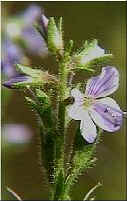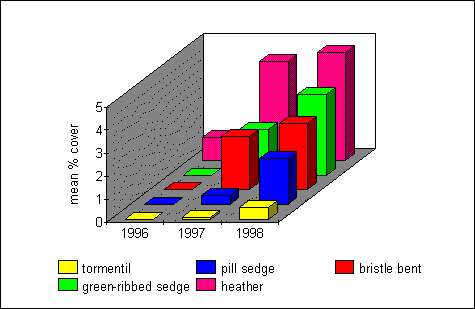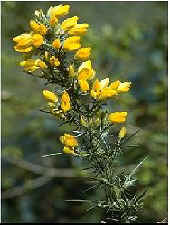The Woodland Education Centre
Heathland Project Report
Introduction List of Summary Points Summary
Heath Species on the Project Site
 left: Heath Speedwell.
left: Heath Speedwell.
The survey results indicate that the vegetation on the Offwell project site is making slow but steady progress towards becoming a dry heath community. Heather (Calluna vulgaris) is present in many areas of the site and is gradually spreading
(% frequency has increased from 6 - 12% over the three year period). Bell Heather (Erica cinerea), while less common, has also increased from 0.8% - 3% frequency over the same period (species list).
The mean % cover for Heather over the whole site was 1% in 1996. This had increased to 4.7% by 1998, by which time Heather had become the eighth most dominant plant overall on the heathland in terms of percentage cover
(Table ). In some areas of the site (section 9), Heather is now the dominant plant .
Bell Heather is taking longer to become established. Its overall percentage cover in 1996 was 0.1%. This had increased to 0.6% by 1998.

Changes in mean % cover of some heath species 1996 - 1998
Re-seeding with heather cuttings from remnant heathland areas has not been necessary on the project site. Heather and Bell Heather are regenerating naturally. They are either regenerating from seed banks still viable in the soil, or from seed dispersing onto the project site from adjacent areas in the Woodland Education Centre. These species are found growing freely in several areas of the Centre, indicating that conditions are generally favourable for heathland vegetation over much of the region. It is likely that in the past much, if not all of the area, was covered in heathland. This makes the task of regenerating heathland much simpler because the necessary conditions are already present.
Heather/Bell Heather Distribution on the project site.
Heather Life Cycle Stages
Cross-leaved heath (Erica tetralix) has not so far been found on the project site.
 left:
Common Gorse is well established on the Heathland Restoration site.
left:
Common Gorse is well established on the Heathland Restoration site.
The other most noticeable component of heathlands, Gorse, is now well-established on the site. Common Gorse (Ulex europaeus) is one of the most dominant species overall, although its dominance is gradually decreasing (Table ). Mean % cover of Common Gorse has decreased from an initial high of approximately 18% in 1986 to stabilise at around 9% cover over the past two years (Table ). This is likely to be due to increased competition with other species on the site, in particular with grasses such as Common Bent and Yorkshire Fog, as a consequence of the management practices currently in place.
Common Gorse is normally confined to the margins, boundary banks and areas of disturbed soil on well-established heathlands. It seldom occurs on open heath where it is replaced by either Dwarf Gorse (Ulex minor) or Western Gorse (Ulex gallii). Western Gorse, as its name suggests, occurs mainly in the west of England. Dwarf Gorse is the eastern species. The ranges of these two species overlap to the east of Devon, in Dorset.
Western Gorse occurs in other areas of the Woodland Education Centre, but was not found on the project site until 1998. It was then represented by two small plants.
Continue to species
present list ![]()
| Heathland Restoration Project Report | ||||

Other Lowland
Heaths in East Devon
Project site's most dominant plants Heather distribution Heather life-cycle stages and succession